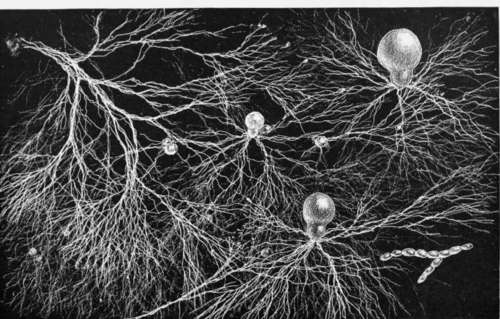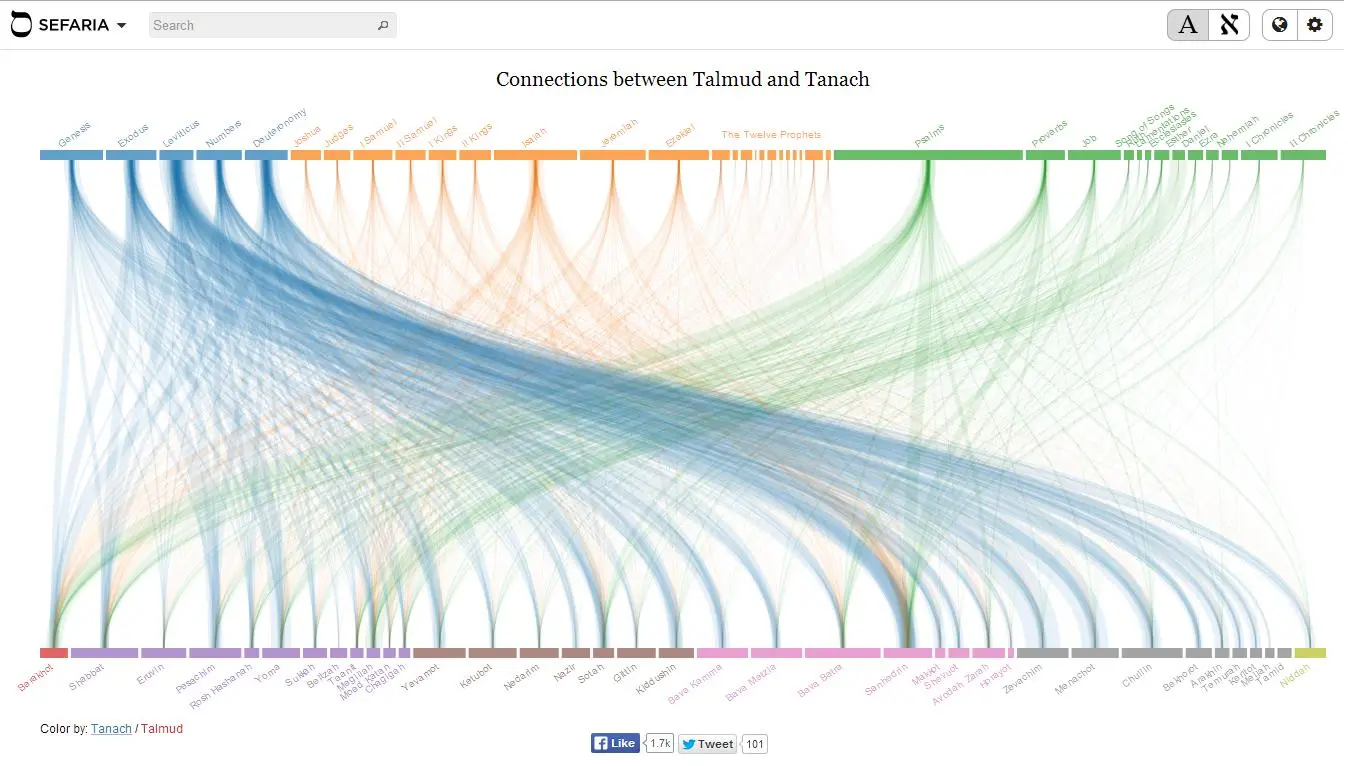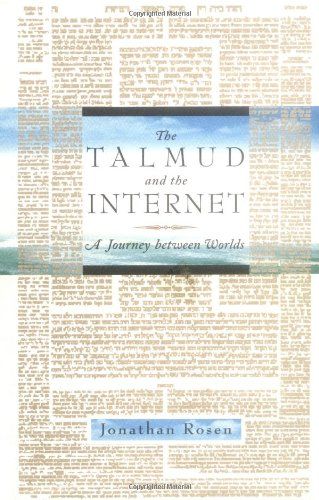Shabbat Gathering: Star Trek, Mushrooms, and Sefaria.

Dear Chevra, as is our custom, we will gather tonight at 5.45p ct to welcome Shabbat. These are the coordinates:
Zoom
Meeting ID: 963 5113 1550
Password: 1989
Phone: +1 312 626 6799
Rabbi Laurie will be joining us.
(To unsubscribe from the newsletter, click the link at the very bottom of this email.)
Here we go.
It’s without exaggeration I claim Sefaria is probably the most important innovation in Jewish studies ever. E-ver. From the beginning of the written Torah up to right now, there have been significant advances in the creation, production, and distribution of individual texts, but no single innovation has knitted together all the Jewish texts the way Sefaria has. And Sefaria is just getting started. Sefaria has put Jewish texts into the hands of those of us who are online and has connected those texts together in a way that could only be imagined until now. And it’s magic.
Strap in. I’m taking you on a journey. Let's fly.
Star Trek: Going where no one has gone before.
One of the cool things about moving to Arkansas to take care of my mother is that I get to study Torah / Talmud all day and all night long. Ok, you caught me out. The amount of time I spend studying Torah has increased, but I’m also indulging some other interests of mine. For example, I discovered I can watch every episode of every Star Trek series ever made. Mom and I have watched about 400 episodes of different Star Trek series and there’s plenty more. We mix old series with the new series including Star Trek: Discovery. In Star Trek: Discovery, there is a new way of traveling through space that’s even faster than warp speed: It’s a mushroom network.

Consider the humble ‘shroom.
About twenty years ago, scientist discovered that mushrooms have vast root systems that can extend for hundreds, maybe thousands of miles. In Star Trek: Discovery, it’s been discovered that this mycelium network extends into outer space and space ships can zip around the universe by getting inside this network and follow the root system that connects everything to everything else. It’s cool.

Not for nothing, these are mushroom networks and, as some of us may have experienced (wink, wink), some mushrooms have “magical” properties. Ingestion can result in a new perception of our universe wherein everything is connected with everything else. And the result of this temporary change in perception even just once can result in a permanent change in perception, for the better I think.
And it all has something to do with the development of Sefaria, a web site that takes our Jewish texts and draws the connections between them. Hang in there and give me a chance to explain.

Information in general - actually everything that’s been documented throughout human history - is experiencing a similar innovation. Google was founded in 1998 and since then has digitized and indexed an unimaginable amount of information. In 2000 when Google was still a toddler finding its legs, a writer at The Forward, Jonathan Rosen, published a book called The Talmud and the Internet. In the book, Rosen wrote a vision of the future where all Jewish texts were all freely available on the internet and all cross referenced. Consider this...

I have often thought, contemplating a page of Talmud, that it bears a certain uncanny resemblance to a home page on the Internet, where nothing is whole in itself but where icons and text boxes are doorways through which visitors pass into an infinity of cross-referenced texts and conversations.
and...
And yet when I look at a page of Talmud and see all those texts tucked intimately and intrusively onto the same page, like immigrant children sharing a single bed, I do think of the interrupting, jumbled culture of the Internet. For hundreds of years, responsa, questions on virtually every aspect of Jewish life, winged back and forth between scattered Jews and various centers of Talmudic learning. The Internet is also a world of unbounded curiosity, of argument and information, where anyone with a modem can wander out of the wilderness for a while, ask a question and receive an answer. I take comfort in thinking that a modern technological medium echoes an ancient one.
In 2011, 11 years later, a former engineer from Google, Brett Lockspeiser, and a journalist, Joshua Foer (yes, he's the brother of Jonathan Safran Foer, the novelist), founded Sefaria as a vast trove of our Jewish texts, available for free, and began cross referencing them. This might be blindingly obvious from today’s perspective, but at the time, it seemed to be an insurmountable challenge. And yet that’s what happened, and Sefaria has become an indispensable resource for Jews around the world.
So here’s the deal.
The idea of making Jewish texts freely available online is a big deal in and of itself. The idea of cross referencing all Jewish texts is nothing short of a miracle. It is actually a historic moment in our Jewish story.
Before Sefaria, if one wanted to find out what Rashi had to say about a portion of Torah, one would have to read Rashi and remember what one had read to apply to Torah or get a special purpose book that combines the two. Some indexes and concordances have been published, but they were very expensive and awkward to use. In the end, one still needed to acquire or have access to a vast library of Jewish texts.
So, the first thing about Sefaria is that it offers access to all its texts … for free ... at your fingertips. This includes thirteen different English translations of Torah. (Surely one of them is going to be the one you feel comfortable with.) Beyond English, there are translations in German, Spanish, French, Italian, Polish, Portuguese, Esperanto, and other languages. And that’s just Torah.
Add Talmud. Add Midrash. Add Halakhah. Add Kabbalah. Add liturgy. And keep on adding month after month, year after year. That’s what Sefaria is doing. Texts in the public domain are being added. Some of the texts beyond the public domain are being added. Public domain texts that need to be translated are being translated by a crowdsourced effort and added. And Sefaria is only eleven years old. My mind quails at what Sefaria will be ten years down the road, or for that matter just five years on.
Sefaria is available through your web browser. On your smartphone (iPhone or Android), there’s an app. And it’s all free. Sure, one can contribute money to the effort, and all contributions are most welcomed and encouraged, but Sefaria is free to use.
One thing about Sefaria that might go unnoticed by individuals is that it has published application programming interfaces (APIs) to its work. This means that Sefaria is open source and that other organizations can use these APIs to create their own applications that build on the good work Sefaria has already done.
Now, let’s kick this up one more level. How does Sefaria evolve beyond all the texts that have ever existed and help capture new thoughts and opinions? The first step Sefaria has taken is a combination of note taking and writing called Sheets. First, Sheets help highlight the connections we discover on Sefaria and want to put to work in lectures, drashes, and articles. Next, it is a space where people can write their own midrash, ideas, and responsa. And it is a space that is searchable and discoverable by other users.
But wait, there’s more.
Want to study Daf Yomi? Sefaria can help with that too. It offers a well-supported program.
Interested in finding and working with a study partner, a chavruta? Sefaria can help with that.
Need to ramp up your Torah study? Sefaria is an excellent resource for that.
How about learning Mussar or Chasidut? Resources and texts are available.
And I could go on and on.
We are living in the future.
A very dear friend of mine has a catchphrase I like a lot: “We are living in the future.” Every time I open Sefaria, I’m convinced of that more than ever. I’m just a student (better Yiddish/chess word: patzer) of Jewish texts, but I can see and feel that Sefaria has fundamentally changed how I interact with Jewish texts.
With Sefaria, I can see how everything is connected to everything else, just like with the mycelium network. And just like in Star Trek: Discovery, Sefaria helps me move through those connections really fast. Sefaria has fundamentally changed my own perception of not only how I study but what I study. Sefaria makes everything connected.
And may it be for you a blessing,
Gut Shabbes,
All my love,
brian.
PS
I just received an update from Sefaria about the new texts it is offering. These include...
- Midrash written by contemporary Israeli women.
- Tu b'Av texts. Tu b'Av is like a Jewish Valentine's day except a bit more focused on women.
- A biography of Rebbe Nachman.
... and more.
Sefaria is constantly offering new texts and features.